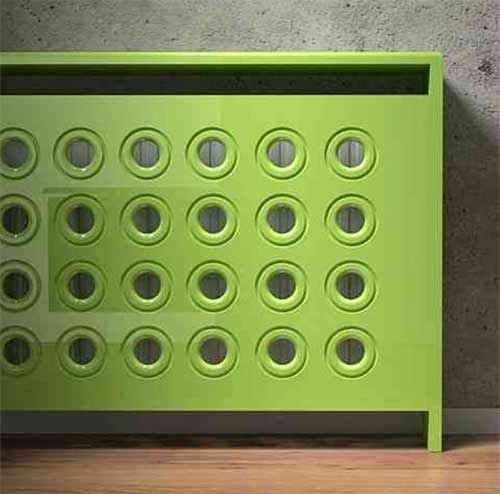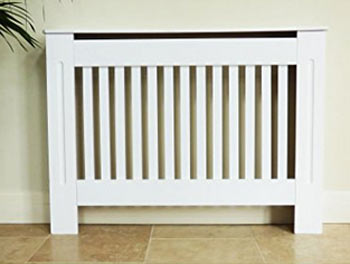Ugly, damaged or unsightly radiators can spoil the look of even the most beautifully decorated room and with this in mind, a radiator cabinet offers the perfect solution to conceal old and unfashionable radiators.
From sophisticated contemporary styles to more traditional designs, there are radiator cabinets to match every home and provide attractive and effective protection from hot surfaces.
This guide looks at everything you need to know about them, including how they are fitted.
Types of Radiator Cabinets
Radiator cabinets come in various designs and materials, with something to suit every possible taste and decor. The primary purpose of these cabinets is to cover unsightly radiators while improving safety and enhancing the overall look.
When it comes to the different radiator cabinets available, initially they all fall into one of the two below types:
- Fitted: The cabinet is fixed in place via brackets and is hung on the wall.
- Free Standing: The cabinet is simply placed over the radiator without fixing to the surface behind.
Aside for the above, each radiator cover can also be classified as one of the below:
Wooden Radiator Cabinets
Wooden radiator cabinets are among the most popular choices due to their versatility and classic look. They can be made from solid wood or MDF (medium-density fibreboard) and come in a variety of finishes, including painted, stained, or varnished. Wooden cabinets can easily be customised to fit any space and match pretty much any design scheme, making them an excellent option for both traditional and modern homes.

MDF radiator cabinet
Metal Radiator Cabinets
Metal radiator cabinets offer a sleek and modern appearance, making them ideal for contemporary homes. Typically made from steel or aluminium, these cabinets are durable and often have perforated designs to allow heat to circulate efficiently. Metal cabinets are available in a range of colours and finishes, including matte, gloss, and even powder-coated options for added durability.

Metal radiator cabinet – Image courtesy of radiatorcabinetsuk.co.uk
Glass Radiator Cabinets
For a more luxurious and minimalist look, glass radiator cabinets are an elegant option. These cabinets are usually made from toughened glass for safety and feature a streamlined design that seamlessly blends into modern interiors. Glass radiator cabinets can be frosted or clear, providing a sophisticated touch while still allowing efficient heat output.

Glass radiator cabinet – Image courtesy of my-furniture.com
Custom-Built Radiator Cabinets
If you have a uniquely shaped radiator or a specific design in mind, custom-built radiator cabinets may be the best solution. These are made to measure, ensuring a perfect fit and allowing for complete customisation of materials, finishes, and design features. Custom cabinets provide the ultimate flexibility for creating a seamless look in any room.
Maximise Heat While Hiding Your Radiator
Poorly designed radiator covers can cause significant heat loss. To minimise this, choose a radiator cabinet that’s properly sized and positioned, keeping heat loss under 10%.
Good airflow is essential for heat efficiency. Focus on the top and bottom grills of the cabinet—cool air enters through the bottom grill, while warm air exits through the top. This ensures maximum heat distribution.
When positioning your radiator cabinet, make sure it fits within the available space, considering nearby furniture, windows, and other features.
Note: Cabinets are not suitable for storage or convector heaters.

Cold air enters the bottom of the radiator cabinet and leaves as hot air at the top
Do Radiator Covers Cause Heat Loss?
In short, yes, radiator covers do in most cases cause some heat loss, as you are effectively covering them over, however if done correctly, heat loss is kept to a minimum, normally around 10% give or take.
However, if the wrong cabinet is installed e.g. it’s too small, too close , made from the wrong materials etc. this figure can be a significant amount higher. The key is ensuring the cover promotes good airflow, allowing the radiator to function efficiently.
The majority of heat loss occurs when a radiator cover blocks air circulation. Radiators work by heating the air around them, causing the warm air to rise and spread throughout the room and the cold air replacing it is then also heated, this causes convection. If the top or bottom grill of the cover is obstructed, it limits this natural convection process, trapping heat inside the cabinet. To avoid this, choose a cover with well-ventilated top and bottom grills. These openings allow cool air to enter from below, heat up, and escape from the top, maintaining effective heat distribution.
When it comes to materials, thick, insulated materials can act as a barrier, absorbing some of the heat that would otherwise warm the room. Opt for lightweight materials with proper ventilation to minimise this effect. Additionally, ensure the cabinet is not too close to the radiator, as this can stifle heat output.
How to Measure for a Radiator Cabinet
Accurate measurements are essential when choosing a radiator cabinet. Be sure to account for any thermostats or valves. The key measurements you need are height, width, and depth, which will determine the cabinet’s dimensions.
- Height: Measure from the floor to the top of the radiator, then add 25mm to allow for proper airflow.
- Width: Measure the total width of the radiator, including any valves, and add 50mm (25mm on each side) for circulation space.
- Depth: Measure from the wall to the front of the radiator and add 25mm to ensure good air circulation.

Dimensions of a radiator
Do Radiator Covers go Over the Thermostat?
The answer here is a most definitely no! If you totally block off the thermostat and it sits inside the cover, it will most probably read a higher temperature than the actual room temperature, causing the radiator to shut off much sooner than it should do.
To counteract the possibility of this happening, many radiator covers today are designed with cut-outs or openings to accommodate the thermostat and allow it to work properly and as it should.
To avoid trapping heat, make sure there is enough space around the thermostat, allowing air to circulate freely around the radiator and thermostat, so that all operates as it should do.
How to Fit a Radiator Cover
Now that you know how to select the right radiator cabinet for your radiator, we can now look at how they are fitted.
There are many different radiator covers on the market today, produced by many different manufacturers. They all feature slightly different brackets and fitting methods, however the below guide should cover pretty much all of these in terms of general fitting principles.
Step 1: Measure and Choose the Right Size
Before fitting, ensure you have measured your radiator correctly. As stated above, add extra space for air circulation, typically at least 25mm around the height, width, and depth of the radiator. This ensures the cover won’t block airflow and affect heating efficiency.
Step 2: Assemble the Cover
Most radiator covers come flat-packed. Follow the manufacturer’s instructions to assemble the cover. This usually involves attaching side panels to the top and front panels using screws or dowels provided with the kit. Make sure the assembly is sturdy before proceeding.
Step 3: Position the Cover
Once assembled, carefully place the cover over the radiator. The cover should sit flush against the wall, leaving enough space for air to flow through the top and bottom grilles. Check that the cover does not obstruct any valves or thermostats.
Step 4: Secure the Cover
To prevent movement, especially in homes with children or pets, secure the cover to the wall. Many covers come with brackets or hooks that can be easily attached to the wall. This ensures the cover stays in place while allowing easy access to the radiator when needed. See our fixing to masonry walls and fixing to plasterboard projects for help on how to do this.
Step 5: Test Airflow
Once installed, turn on your heating system to ensure the radiator cover allows sufficient airflow. Check that the radiator is heating the room efficiently, and adjust the cover’s positioning if necessary.

Example of a radiator cover available on Amazon
Most radiator covers are not permanently fixed; they are simply free-standing to allow easy access to the controls. While this makes installation quicker and simpler, it also means the cover is less secure. Avoid placing anything valuable on top, especially if there are active kids in the house!

